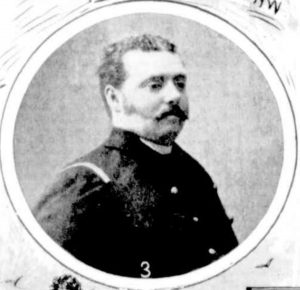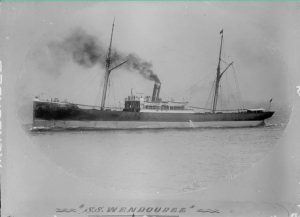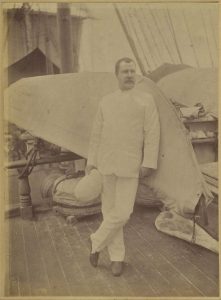When houses were being built in Arcadia Rd, two were for families of sea captains, also known as master mariners. Captain Percy William Bull moved into No. 3 in 1895 and Captain John Bolton Carpenter into No. 47 in 1900.
Percy William Bull

Percy William Bull was well known as the master-in-charge of ships on the coastal routes between NSW, Victoria and Tasmania, and across the Tasman Sea to New Zealand.
He was born on 24 January 1857 at Geelong, Victoria, where he grew up. He was the eldest son of English parents William John Bull and Caroline Munroe. He had one brother, Stanley (1860-1941) and four sisters, although only Ada (1863-1923) and Leura (1867-1937) lived to adulthood.
Why Percy chose to go to sea is not known; his father and brother both had land-based occupations. His father was a successful chemist and druggist. Percy probably gained much seaborn experience from the Port of Geelong. He was 26 when he joined the firm of Huddart Parker & Co as second mate on the new steamer Wendouree in 1883.
Huddart Parker & Co had been founded in Geelong in 1876, from the amalgamation of firms that preceded them. The company’s success was mainly from shipping coal from Newcastle, NSW, to Geelong for the nearby goldfields and towns. By the late 1880s the firm had steamers carrying passengers and cargo to and from the principal ports of NSW, Victoria, Tasmania, South Australia and Western Australia. Captain Bull’s expertise was recognised as he grew with the firm and became part of the senior management. Huddart Parker’s competitors were the Union Steam Ship Company of New Zealand and the Tasmanian Steam Navigation Company. Competition between the shipping companies in those days was, in many ways, similar to the numerous airlines currently competing for passengers and business in Australia and New Zealand today.

Percy married Isabella (née Blair) on 10 April 1888 at Christ Church, St Kilda, Victoria. Isabella was from Scotland and was brought to Melbourne by her uncle in 1883, along with some of her siblings. Percy and Isabella’s family home was in the Toorak area.
Huddart Parker’s head office moved from Geelong to 466 Collins St, Melbourne in 1890. In Sydney, their steamers departed for Melbourne and Geelong from the wharf at the bottom of Margaret St at Darling Harbour.
Around 1892, Percy’s home port was Sydney, and in June 1895, the family moved to No. 3 Arcadia Rd. By this time, Percy and Isabella had five children: Mira (b. 1888), Cyril (b. 1890) and Reginald (b. 1891), all born in Melbourne, and Leslie (b. 1893) and Douglas (b. 1894), both born in Balmain.

The Sands Directory records show the family lived at No. 3 Arcadia Rd for four years. Their next two children, Kenneth (1899) and Hector (1901), were born in Melbourne; however, Percy retained No. 3 Arcadia Rd until 1905 when it was sold to Ellen Foley, a widow of Glebe Point.
Percy became the manager of the firm’s Melbourne office in 1899 then the company’s general manager. He retired in 1921 after 43 years with the firm. There is no doubt Percy had made a major contribution to the success of Huddart Parker & Co.
The company was taken over by Bitumen and Oil Refineries Australia in October 1961. This company became Boral in 1963, which today is a multinational company manufacturing and supplying building and construction materials.
Percy died in Melbourne on 21 June 1930, aged 73.
John Burton Carpenter
Captain John Burton Carpenter had a vastly different career at sea from that of Percy Bull. John Carpenter was born in New Haven, Connecticut, USA, on 19 December 1844. His father was an Englishman from Oxford, and his mother was an Englishwoman from Kent.
On 29 May 1872 and halfway around the world, John married American-born Emma Frances Griffin in Singapore. Singapore was the family’s base for the next five years where Herbert (1873-1953), John (1874-1955), Arthur (1875-1946) and Walter (1877-1954) were born. Amy (1884-1964) was born on the island of
Ambon and William (1885-1952) at an as yet unknown location. Their last child, Harry, was born in Wigram Rd, Glebe in 1887 and died 10 months later.
During the 1870s, ’80s and ’90s John Carpenter sailed the seas near the Dutch-controlled Spice Islands. It was a time when the British were claiming to be global masters of the seas. In 1891, John became embroiled in a conflict between the titans, Holland and England. He was the captain of the Costa Rica Packet, which left Sydney in July 1891 on a whaling expedition to the Molucca Sea. In November, the Costa Rica Packet called in to Ternate Island for supplies. While today the city of Ternate on Ternate Island is the largest city in the Indonesian province of North Maluku, in the 1890s the island was under Dutch control and an administrative centre for a large region, including all of Dutch-controlled New Guinea.

John was arrested and imprisoned by the Dutch for four weeks on a charge of piracy for an incident dating back to 1887. John Carpenter had come upon an abandoned vessel and salvaged some items from the vessel’s waterlogged prow. He had recorded this event in the ship’s log and claimed it was lawful under British maritime law when on the high seas and outside Dutch jurisdiction. This story filled the Australian newspapers following his arrival ‘with child’ (presumably Herbert) at Thursday Island on the ship Dorunda on 10 January 1892 while en route to Sydney.1
Reunited with Emma and family at Wigram Rd, John sought redress for the ignominy he suffered as a result of his incarceration and for the loss of the whole whaling season. In December 1895, the matter went to arbitration in London, and Captain John gave evidence in June 1896. He returned to Sydney in August 1896 but had to wait until February 1897 to get the welcome news that the Dutch Government had been ordered to pay damages of £7,900 to the wronged parties, plus costs.
Emma purchased the vacant lot for No. 47 Arcadia Rd in July 1898 for £225. The house still stands. The Sands Directory shows that this was the family home until 1906.
The Costa Rica Packet was part of island traders’ Burns Philp & Co.’s fleet in 1890. Captain J. B. Carpenter had gained considerable knowledge of the islands to Australia’s north, and he became a senior member of the firm.
In 1898 Carpenter travelled to Hong Kong to take delivery of the steamer Jacob Christensen, built in 1881. On delivery, the steamer was renamed Morseby2. In mid-1899, Carpenter sailed to England on behalf of Burns Philp & Co. to supervise the construction of a new steamer, Mambare. He sailed the ship back to Sydney from Liverpool, arriving on 27 April 1900. 3
After retiring from Burns Philp, Captain J. B. Carpenter became an assessor for the Marine Court based in Sydney. In 1905, at the age of 60, he had purchased five lots in a new residential subdivision at Killara near the new railway line. Subsequently, No. 2 Northcote Ave Killara was built as the family home. The other lots were later sold or transferred to family members. At this time, Carpenter’s sons were making their own way in the world, many with Burns Philp & Co. Herbert and John became managers then directors of the firm. Arthur became the Deputy Director-General of the NSW Land Titles Department.
Walter was educated at Forest Lodge Public School until the age of 14 when he left school to help the family
by working at Burns Philp & Co. In 1899, Walter left Burns Philp to help establish the family pearl-shelling business, J. B. Carpenter & Sons. In 1908, Walter left his brother, William, in charge at Thursday Island and rejoined Burns Philp & Co. in Sydney where he stayed for a time before going to Fiji to manage one of Burns Philps’ subsidiary companies. By 1914, at the age of 37, Walter had formed his own firm, W. R. Carpenter & Co, which established plantations, stores, trading stations and shipping services to the southwest Pacific. W. R. Carpenter became a highly successful firm that competed with Burns Philp. Walter was knighted in 1936.4
In 1908, Captain John B. Carpenter’s daughter, Amy, married Fred Bennet Bailey, a jeweller and director of Stewart Dawson & Co. William, who had been put in charge of the pearl-shelling business on Thursday Island, continued there well into the 1930s. After that, William became a director of W. R. Carpenter and lived in Mosman.
Captain J. B. Carpenter died on 27 April 1921 aged 76 and was buried at Waverley Cemetery. His widow, Emma, lived near Amy at Waverton for the next 20 years before she died on 17 September 1941 aged 88.
Notes: 1. Queensland Times; Tue 12 Jan 1892, p. 5; 2. Daily Telegraph; Tue 19 Apr 1898, p. 4; 3. Daily Commercial News; Sat 28 Apr 1900, p. 4; 4. See also Australian Dictionary of Biography: https://adb.anu.edu.au/biography/carpenter-sir-walter-randolph-5510/text9379









One comment. Please add yours.
Very interesting thanks for this. Carpenters still continue to have an interesting legacy.